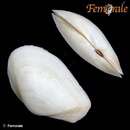zh-TW
在導航的名稱


Die Weiße Bohne (Thracia phaseolina) ist eine Muschelart aus der Familie der Spatelmuscheln (Thraciidae).
Das ungleichklappige Gehäuse wird bis 40 Millimeter lang. Die rechte Klappe ist stärker gewölbt und etwas größer. Es ist ungleichseitig, die Wirbel sitzen hinter der Mittellinie. Es ist im Umriss eiförmig. Der vordere Dorsalrand ist länger als der hintere Dorsalrand und setzt auch deutlich höher an. Der vordere Dorsalrand ist leicht konvex gerundet und geht ohne merkliche Kante oder Knick in den breit gerundeten Vorderrand über. Der hintere Dorsalrand ist fast gerade bis leicht konkav gekrümmt. Der Übergang zum leicht konvex gebogenen, abgestutzten Hinterrand ist deutlich gewinkelt. Der Hinterrand geht ebenfalls deutlich gewinkelt in den weit gerundeten Ventralrand über. Die beiden Klappen klaffen an beiden Enden.
Das externe Ligament ist ein kurzes, breites, dunkelbraunes Band hinter den Wirbeln. Der intern liegende dicke Teil sitzt in einer dreieckigen Grube. Das Schloss weist ein kurzes, vergleichsweise tiefes Lithodesma (Knorpelträger) vor dem Ligament auf, ist ansonsten zahnlos. Die Mantellinie ist eingebuchtet, die Bucht erreicht das hintere Ende des Ligamentgrube. Der ventrale Teil der Mantelbucht fällt nicht mit dem Mantelrand zusammen. Der vordere Schließmuskel ist dünn, der hintere dick.
Die weißliche Schale ist dünn und zerbrechlich. Die Ornamentierung besteht aus konzentrischen Linien, die sehr fein gekörnelt sind (nur unter dem Mikroskop sichtbar!). Die Körnelung ist am Hinterende etwas gröber. Der Innenrand des Gehäuses ist glatt. Das sehr dünne Periostracum ist hellbraun bis gelb; es ist meist abgerieben.
Das Verbreitungsgebiet der Art reicht von Island und Nordnorwegen bis Angola und den Kapverdischen Inseln. Sie kommt auch in der Nordsee und der westlichen Ostsee sowie im Mittelmeer und Schwarzen Meer vor. Nachgewiesen ist sie aus den Gewässern um Madeira.
Sie lebt eingegraben in schlickigen Sand, Sand oder sandigen Kies von der Gezeitenzone bis in etwa 70 Meter Wassertiefe.
In der Literatur und z. T. auch noch auf neueren Internetseiten ist die Art auch noch unter Thracia papyracea (Poli, 1791) zu finden. Tellina papyracea Poli, 1791 (Dezember 1791) ist jedoch ein jüngeres Homonym von Tellina papyracea Gmelin, 1791 (vor Mai 1791) und deswegen ungültig. An seine Stelle tritt nun das nächst jüngere Synonym, das ist Amphidesma phaseolina Lamarck, 1818.[2][3]
Die Weiße Bohne (Thracia phaseolina) ist eine Muschelart aus der Familie der Spatelmuscheln (Thraciidae).
Thracia phaseolina is a bivalve mollusc in the family Thraciidae.[1]
The ovate shell is oblong, transverse, equilateral and inequivalve. The beaks are small; that of the left, slightly notched. The valves are white, diaphanous and smooth, indistinctly marked with striae of increase, rounded at the anterior side, strongly truncated at the posterior side. The side is bounded outwardly by an obtuse angle, pretty prominent, extending obliquely from the beak to the lower part of the shell. The cardinal edge is thin, and without teeth. It presents upon the posterior side the beaks with a small, internal, short, triangular hollow, in which is attached a small internal ligament which is apparent externally. The valves are white and shining, internally. The anterior muscular impression is elongated, the posterior is rounded, and is united to the anterior by a pallial impression, deeply notched.[2]
Thracia phaseolina is found in the North Atlantic Ocean and in the North Sea It is also found in the Mediterranean Sea and in the Gulf of Mexico.
Thracia phaseolina is a bivalve mollusc in the family Thraciidae.
De gewone papierschelp (Thracia phaseolina) is een tweekleppigensoort uit de familie van de Thraciidae.[1] De wetenschappelijke naam van de soort is voor het eerst geldig gepubliceerd in 1818 door Lamarck.
Bronnen, noten en/of referenties